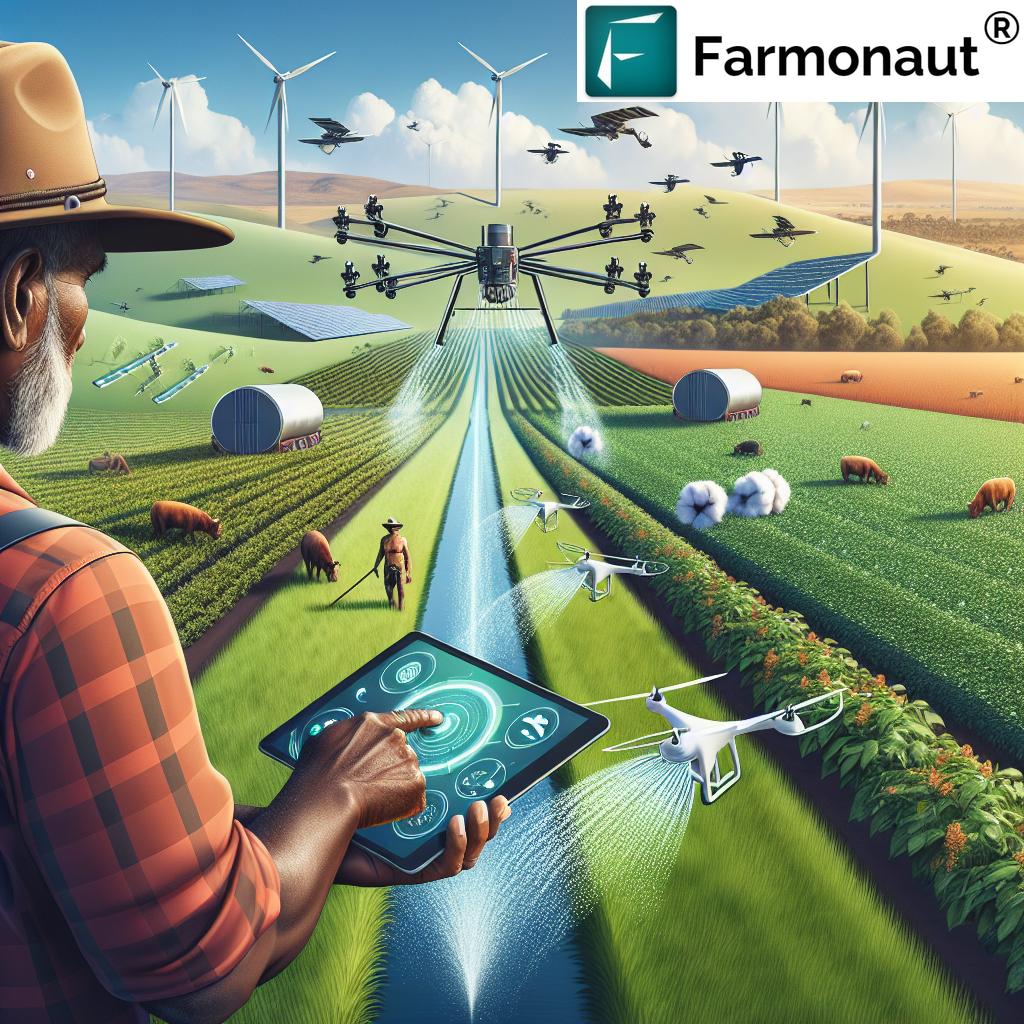Revolutionizing Australian Agriculture: Emerging Agritech Solutions for Sustainable Farm Management and Crop Health
“Australian agritech innovations have contributed to a 30% increase in sustainable farming practices over the last decade.”
Welcome to our comprehensive exploration of the cutting-edge advancements transforming Australian agriculture. As we delve into the world of emerging agritech solutions, sustainable farm management practices, and innovative approaches to crop health, we’ll uncover how these developments are shaping the future of farming Down Under.

In recent years, Australia has emerged as a hotbed of agricultural innovation, with farmers, researchers, and agritech companies working together to address the unique challenges faced by the continent’s diverse agricultural sectors. From the vast wheat fields of Western Australia to the tropical fruit orchards of Queensland, we’re witnessing a revolution in farming practices that promises to enhance productivity, sustainability, and resilience in the face of climate change.
Precision Agriculture: The Cornerstone of Modern Farming
At the heart of Australia’s agricultural transformation lies precision agriculture technology. This approach combines data-driven insights with advanced machinery to optimize every aspect of crop production. Let’s explore some of the key innovations in this field:
- Satellite-based crop monitoring: Companies like Farmonaut are leading the charge in providing farmers with real-time insights into crop health through satellite imagery. This technology allows for early detection of issues such as pest infestations, nutrient deficiencies, and water stress.
- Variable rate technology (VRT): Australian farmers are increasingly adopting VRT systems that adjust the application of inputs like fertilizers and pesticides based on precise field data, reducing waste and improving yields.
- GPS-guided machinery: Automated tractors and harvesters guided by GPS technology are becoming commonplace, improving efficiency and reducing operator fatigue.
The adoption of precision agriculture technologies is not only improving productivity but also contributing to more sustainable farming practices by optimizing resource use and reducing environmental impact.
Smart Farming Solutions: The Digital Revolution in Agriculture
The integration of digital technologies into farming operations is ushering in a new era of smart farming in Australia. These solutions are empowering farmers with unprecedented control over their operations:
- Farm management software: Platforms that centralize data on crop yields, weather patterns, and market prices are helping farmers make more informed decisions.
- IoT sensors and connected devices: From soil moisture sensors to weather stations, these tools provide real-time data that can be accessed remotely, allowing for timely interventions.
- Artificial Intelligence (AI) and Machine Learning: These technologies are being used to predict crop diseases, optimize irrigation schedules, and even forecast market demands.
To explore how these smart farming solutions can benefit your agricultural operations, consider checking out Farmonaut’s comprehensive platform. You can access their services through their web application or by downloading their mobile apps:
Drone Technology: A Bird’s-Eye View of Crop Health
Agricultural drone applications are revolutionizing the way Australian farmers monitor and manage their crops. These unmanned aerial vehicles offer several advantages:
- High-resolution imagery: Drones equipped with multispectral cameras can capture detailed images of crops, revealing issues invisible to the naked eye.
- Precision spraying: Some drones can carry and distribute pesticides or fertilizers with pinpoint accuracy, reducing chemical use and environmental impact.
- Livestock monitoring: In Australia’s vast rangelands, drones are being used to track cattle movements and assess pasture conditions.
The adoption of drone technology is rapidly increasing, with many farmers reporting significant improvements in crop management and reduced labor costs.
Soil Amendment Techniques: Nurturing the Foundation of Agriculture
Australian researchers and farmers are at the forefront of developing innovative soil amendment techniques to improve soil health and crop yields:
- Biochar application: This carbon-rich material is being used to enhance soil fertility, water retention, and carbon sequestration.
- Microbial inoculants: The introduction of beneficial microorganisms to soil is helping to improve nutrient uptake and plant resilience.
- Organic matter management: Advanced composting techniques and the use of cover crops are being employed to build soil organic matter and improve soil structure.
These soil amendment practices are not only boosting productivity but also contributing to the long-term sustainability of Australian agriculture.

Innovative Pollination Services: Ensuring Crop Reproduction
With the global decline in bee populations, Australian agriculture is exploring new approaches to crop pollination:
- Managed bee programs: Professional beekeepers are working closely with farmers to provide targeted pollination services for crops like almonds and berries.
- Native pollinator conservation: Efforts are underway to protect and encourage native pollinators through habitat creation and reduced pesticide use.
- Mechanical pollination: For some crops, researchers are developing robotic pollinators that can supplement or replace insect pollination.
These innovative pollination strategies are crucial for maintaining and improving yields in many of Australia’s high-value horticultural crops.
“AgriFutures Australia has funded over 100 agricultural development projects, accelerating the adoption of cutting-edge technologies by 40%.”
Emerging Industries: Diversifying Australian Agriculture
Australia’s agricultural landscape is evolving, with several emerging industries gaining traction:
- Industrial hemp production: With changes in legislation, industrial hemp is becoming a valuable crop for fiber, food, and medicinal purposes.
- Seaweed cultivation: Coastal regions are exploring seaweed farming for food, pharmaceuticals, and as a potential solution for carbon sequestration.
- Insect farming: The production of insects for animal feed and human consumption is an emerging industry with significant potential.
These new industries are not only diversifying Australia’s agricultural output but also opening up new export opportunities and contributing to sustainable farming practices.
AgriFutures Australia: Driving Innovation and Growth
AgriFutures Australia plays a pivotal role in shaping the future of Australian agriculture through its funding initiatives and research programs. Some key areas of focus include:
- Rural Research and Development for Profit program: This initiative funds collaborative research projects that deliver practical solutions to industry challenges.
- Emerging industries: AgriFutures supports the development of new and emerging rural industries, such as native foods and novel grains.
- National Rural Issues: The organization addresses cross-sectoral issues affecting rural and regional Australia, such as climate change adaptation and workforce development.
Through these efforts, AgriFutures Australia is helping to ensure the long-term sustainability and competitiveness of the country’s agricultural sector.
Sustainable Agricultural Practices: A Holistic Approach
Australian farmers are increasingly adopting sustainable agricultural practices that consider the long-term health of the land and surrounding ecosystems:
- Conservation agriculture: Techniques such as minimum tillage and crop rotation are being widely adopted to preserve soil health and reduce erosion.
- Integrated pest management (IPM): Farmers are using biological controls and targeted interventions to reduce reliance on chemical pesticides.
- Water-efficient irrigation: Advanced irrigation systems and drought-resistant crop varieties are helping farmers adapt to Australia’s variable climate.
These sustainable practices are not only environmentally beneficial but also contribute to the resilience and profitability of Australian farms in the face of climate change and market pressures.
Specialized Farming Sectors: Innovations in Niche Markets
Australia’s diverse climate and landscapes have given rise to several specialized farming sectors, each with its own unique innovations:
- Kangaroo farming: Sustainable management practices are being developed for kangaroo harvesting, balancing conservation with economic opportunities.
- Tea tree oil production: Advanced distillation techniques and breeding programs are enhancing the quality and yield of this valuable essential oil.
- Ginger cultivation: Disease-resistant varieties and improved processing methods are boosting Australia’s ginger industry.
These specialized sectors showcase Australia’s capacity for agricultural innovation and adaptation to unique environmental conditions.
The Role of Data in Modern Australian Agriculture
Data is becoming increasingly central to agricultural decision-making in Australia. Farmers and agribusinesses are leveraging various data sources to optimize their operations:
- Weather data: Advanced forecasting models help farmers plan planting, harvesting, and other critical activities.
- Market data: Real-time information on commodity prices and trends informs marketing and production decisions.
- Satellite data: Remote sensing provides valuable insights into crop health, soil moisture, and land use patterns.
For those interested in harnessing the power of satellite and weather data for agriculture, Farmonaut offers comprehensive API solutions. You can explore their API services and access detailed developer documentation to integrate these powerful tools into your own applications.
Emerging Agritech Solutions in Australian Agriculture
| Technology/Practice | Application | Benefits | Adoption Rate (%) |
|---|---|---|---|
| Precision Agriculture | Variable rate input application, GPS-guided machinery | Improved resource efficiency, higher yields | 65 |
| Agricultural Drones | Crop monitoring, precision spraying | Reduced labor costs, targeted interventions | 40 |
| Smart Farming Software | Farm management, data analysis | Improved decision-making, streamlined operations | 55 |
| Soil Amendment Techniques | Biochar application, microbial inoculants | Enhanced soil health, increased crop resilience | 35 |
| Crop Health Monitoring Systems | Satellite imagery, IoT sensors | Early disease detection, optimized crop management | 50 |
| Innovative Pollination Services | Managed bee programs, mechanical pollinators | Improved fruit set, higher yields | 30 |
| Seaweed Cultivation | Coastal farming, carbon sequestration | New revenue streams, environmental benefits | 15 |
| Industrial Hemp Production | Fiber, food, and medicinal applications | Crop diversification, sustainable material source | 20 |
The Future of Australian Agriculture
As we look to the future, several trends are likely to shape the continued evolution of Australian agriculture:
- Climate-resilient farming: Development of crop varieties and farming practices adapted to changing climate conditions.
- Vertical farming: Expansion of controlled environment agriculture in urban and peri-urban areas.
- Blockchain in agriculture: Implementation of blockchain technology for improved traceability and supply chain management.
- Autonomous farming systems: Further development of self-operating machinery and robotic farming assistants.
These trends underscore the ongoing commitment to innovation and sustainability in Australian agriculture, ensuring its position as a global leader in the sector.
Conclusion: A Bright Future for Australian Agriculture
The revolution in Australian agriculture is well underway, driven by a combination of cutting-edge technology, innovative farming practices, and a commitment to sustainability. From precision agriculture and smart farming solutions to emerging industries and sustainable practices, the sector is adapting to meet the challenges of the 21st century.
As we’ve explored throughout this blog, the integration of agritech solutions like those offered by Farmonaut is playing a crucial role in this transformation. By leveraging satellite data, AI-driven insights, and advanced analytics, Australian farmers are better equipped than ever to optimize their operations, improve crop health, and contribute to a more sustainable agricultural future.
We encourage all stakeholders in the agricultural sector – from individual farmers to large agribusinesses – to embrace these emerging technologies and practices. By doing so, we can ensure that Australian agriculture remains at the forefront of global innovation, productivity, and sustainability.
FAQ Section
Q: What is precision agriculture, and how is it benefiting Australian farmers?
A: Precision agriculture is an approach that uses technology to optimize crop production by precisely managing inputs like water, fertilizers, and pesticides. It benefits Australian farmers by improving resource efficiency, increasing yields, and reducing environmental impact.
Q: How are drones being used in Australian agriculture?
A: Drones are used for crop monitoring, providing high-resolution imagery for early detection of issues like pest infestations or nutrient deficiencies. They’re also used for precision spraying of pesticides and fertilizers, and for livestock monitoring in remote areas.
Q: What role does AgriFutures Australia play in agricultural innovation?
A: AgriFutures Australia funds research and development projects, supports emerging rural industries, and addresses national rural issues. It plays a crucial role in driving innovation and ensuring the long-term sustainability of Australian agriculture.
Q: How are Australian farmers adapting to climate change?
A: Australian farmers are adapting to climate change through various means, including adopting water-efficient irrigation systems, developing drought-resistant crop varieties, implementing conservation agriculture practices, and using precision agriculture technologies to optimize resource use.
Q: What are some emerging agricultural industries in Australia?
A: Some emerging agricultural industries in Australia include industrial hemp production, seaweed cultivation, insect farming, and native food production. These industries are diversifying Australia’s agricultural output and opening up new market opportunities.















